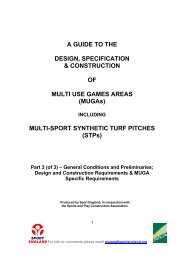View - North East Lincolnshire Council
View - North East Lincolnshire Council
View - North East Lincolnshire Council
You also want an ePaper? Increase the reach of your titles
YUMPU automatically turns print PDFs into web optimized ePapers that Google loves.
BOC Immingham Dissolved Acetylene Project Environmental Statement: Vol. 2 Main Text<br />
11.20 Section 2 of the guidance note outlines the measurement and evaluation procedures that should<br />
be followed. It describes the key components of a noise assessment which include: identification<br />
of the sensitive receptors; review of complaint history; risk assessment; impact assessment; and<br />
implementation of noise control measures if required. It advises the use of:<br />
� BS 4142: Method for Rating Industrial Noise Affecting Mixed Residential and Industrial Areas<br />
for determining the impact of the installation; and<br />
� BS 7445: Description and Measurement of Environmental Noise, Parts 1 to 3, for guidance<br />
on the measurement of environmental noise.<br />
11.21 Section 3 gives guidance on noise control techniques and technologies.<br />
11.22 The guidance refers to the possibility that vibration may need to be assessed and recommends<br />
that specialist advice is sought where impacts from vibration are considered to be a risk.<br />
BS 4142 Method for Rating Industrial Noise Affecting Mixed Residential and Industrial<br />
Areas, 1997<br />
11.23 BS 4142:1997 describes methods for determining and assessing noise levels from fixed plant with<br />
a view to determining the likelihood of complaints.<br />
11.24 The likelihood of complaints about noise from the occupiers of nearby residential properties can<br />
be assessed using the method described in BS 4142:1997. This method compares the rating<br />
noise level to the measured background noise level in the absence of the source. Rating noise<br />
level is defined as the noise level from the source, adjusted for certain acoustical features. It is<br />
measured in terms of dB LAeq which is an energy based acoustic indicator. The standard defines<br />
the ‘specific noise level’ as the LAeq of the source, and the ‘background level’ as the LA90 level<br />
without the source operating.<br />
11.25 Guidance on how to measure the background noise level, LA90, is also provided in the standard.<br />
The length of measurement should be sufficient to obtain a representative value for the<br />
background noise level and should cover all periods when the specific noise will operate.<br />
11.26 The standard states that certain acoustic features can increase the likelihood of complaint over<br />
that expected from a simple comparison between the specific noise level and the background<br />
noise level. Where present at the assessment location, such features are taken into account by<br />
adding +5 dBA to the specific noise level to obtain the rating noise level. A +5 dBA correction is<br />
applied if one or more of the following features occur, or are expected to be present for new or<br />
modified noise sources:<br />
� the noise contains a distinguishable, discrete, continuous note (whine, hiss, screech, hum,<br />
etc);<br />
� the noise contains distinct impulses (bangs, clicks, clatters, or thumps); or<br />
� the noise is irregular enough to attract attention.<br />
11.27 The standard then rates the likelihood of complaints by comparing the rating noise level with the<br />
background noise level:<br />
� where the rating noise level is more than 10 dB above the background level, then complaints<br />
are likely;<br />
� where the rating noise level is more than 10 dB below the background noise level, then this is<br />
a positive indication that complaints are unlikely; and<br />
� where the rating noise level is 5 dB above the background noise level, then this is of marginal<br />
significance.<br />
5100935.404 Environmental Statement August 2011 191




